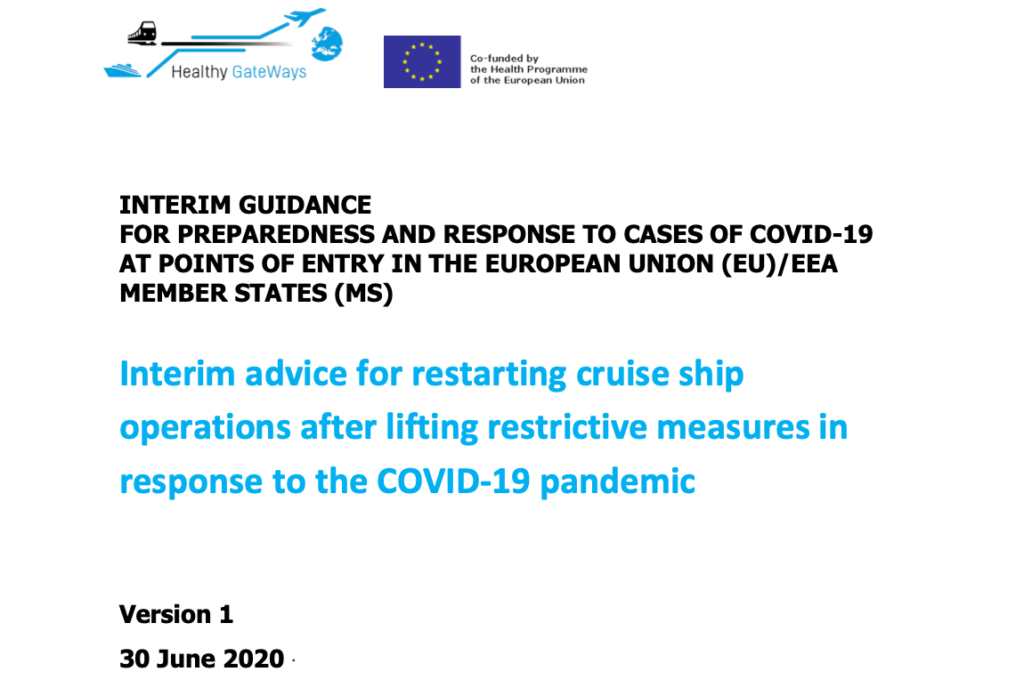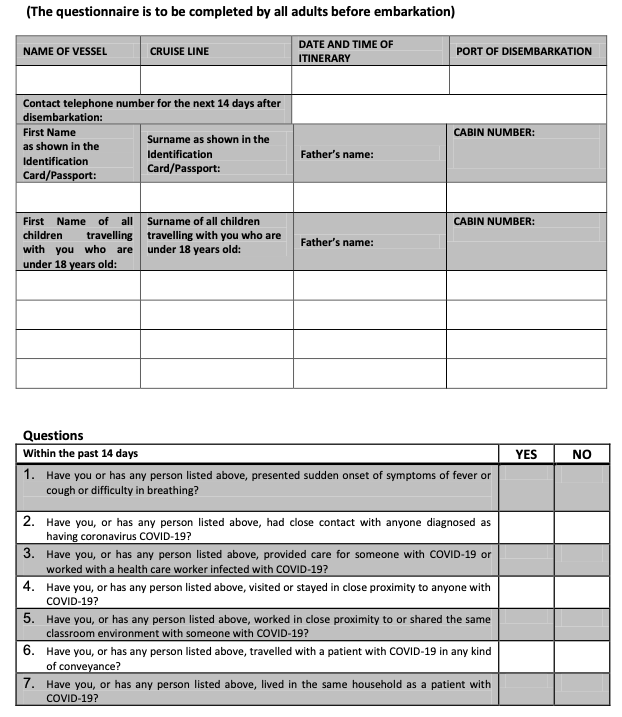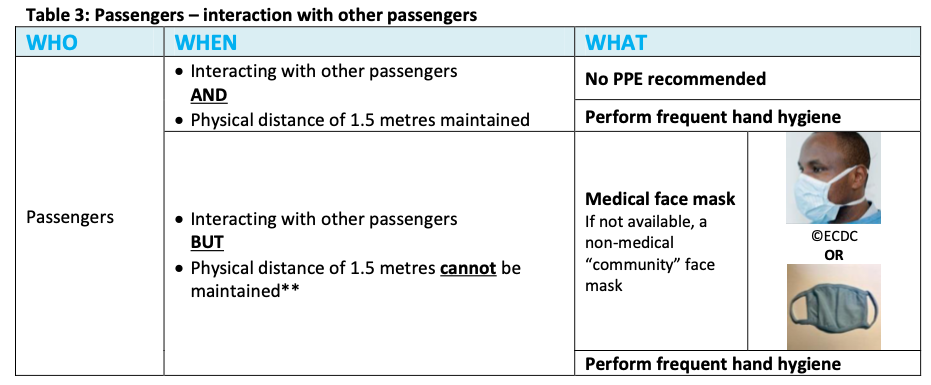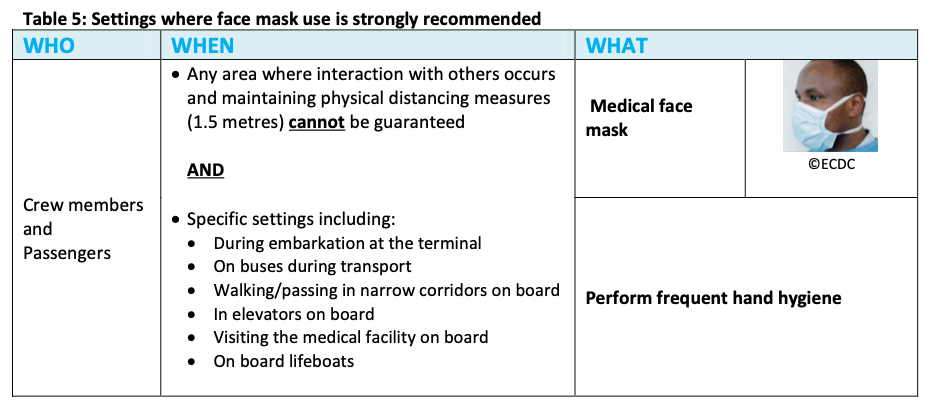On June 30, 2020, EU Healthy Gateways issued interim advice for restarting cruise ship operations once cruise ship are permitted to resume operations in European waters. While this would not impact Disney Cruise Line until the Disney Magic returns to Europe for summer 2021, the following might offer a glimpse into the future of cruising from U.S. ports on cruise ships under The Centers for Disease Control and Prevention’s (CDC) jurisdiction once the CDC’s No-Sail Order is lifted.
Before reading, please understand this is simply guidance published for the European cruise market, and is only intended to provide insight. Before long, I imagine the CDC and CLIA, the world’s largest cruise industry trade association, will issue some sort of guidance that will be adopted by cruise ships operating within U.S. waters.
“The primary concern of CLIA and its member lines is the health and safety of its passengers and crew,” Tom Boardley, secretary-general of CLIA Europe, said in the statement. “This guidance from the public health authorities in Europe provides a useful resource for cruise lines as they prepare to resume operations.”
Cruise Lines International Association statement on EU’s interim guidelines
The purpose of the 49-page report issued by EU Healthy Gateways, is to provide general guidance to the European Union, Member States, and to cruise lines about options for measures on travel and tourism that could be applied after lifting the restrictive measures implemented in response to the COVID-19 pandemic.
The current guidance provides a list of measures to reduce the risk for introduction of COVID-19 onto the ship, transmission during cruise ship voyage, embarkation and disembarkation, and further provides options for preparedness to respond to potential COVID-19 cases among passengers and crew.
EU Health Gateways suggests a gradual approach to restarting cruise ship operations with cruise lines initially limiting sailings to shorter itineraries of 3 to 7 days, and to perhaps limit the number of port visits in the itinerary.
For each ship operating in European waters, a contingentcy/outbreak management plan for responding to a COVID-19 event is required covering the following conditions:
- Monitoring of epidemiological situation, rules and restrictions worldwide including the cruise destinations, and place of passenger and crew origin.
- Each cruise ship should have in place a written contingency plan/outbreak management plan for the prevention and control of possible cases of COVID-19.
- Before departure, cruise ship operators should check and ensure with ports of call that, if needed, arrangements can be made for passengers and crew members to receive medical treatment ashore (including possible air evacuation if needed)
- Cruise lines should ensure with ports along the route that, if needed, repatriations and crew changes can be organised with repatriation plans for passengers and crew members, considering different scenarios for partial or complete ship evacuation in the event of a COVID-19 outbreak.
- Arrangements for quarantine of close contacts – Close contacts that have been exposed to a confirmed case of COVID-19 should disembark as soon as possible, and be quarantined and monitored (self-monitored or otherwise according to the country procedures) for a period of 14 days in quarantine facilities ashore.
- Arrangements should be made between the cruise line and the local authorities for isolation procedures and facilities for asymptomatic/ pre-symptomatic infected travelers. Any person who has tested positive should disembark as soon as possible, be isolated in a facility ashore and monitored until the ECDC criteria for discharge are met.
- Adequate testing capacity on board or in cooperation with shore-based laboratories, to be used when a passenger or crew member is suspected of being infected.
- Training of all crew, as well as external contractors who interact with passengers or crew on board or ashore should complete training about COVID-19.
- Commitment for immediate reporting to the next port of call of any possible case.
- For the initial stage of restarting operations, a reduction of passengers and crew to enable physical distancing onboard the ships and for temporary isolation and quaint of passengers and crew. It is advised the maximum number of crew members in a single cabin should be limited to 2 persons. Cruise should be able to isolate or quarantine based on the following guidance:
- 5% of passengers and 5% of crew on board for ships where it will not be possible to disembark crew and passengers who need to be quarantined or isolated within 24 hours from detection of the first possible COVID-19 case.
- 1% of passengers and 1% of crew for ships where it will be possible to disembark crew and passengers who need to be quarantined or isolated within 24 hours from detection of the first possible COVID-19 case.
- Routine ship inspections focusing on COVID-19 prevention and control.
Prior to embarkation, the report suggests cruise lines develop an exclusion policy with regard to COVID-19 and inform guests via all means available.
Symptomatic and potentially exposed passengers should be discouraged from travelling. Any person experiencing symptoms compatible with COVID-19, or if identified, anyone who has been in contact during the last 14 days with a confirmed case of COVID-19, or anyone who is tested positive would not be accepted on board cruise ships.
High Risk Groups
Special precautions may be applied to passengers and crew belonging to high risk groups. Passengers in high risk groups including people over 65 years of age or people of any age with underlying medical conditions (chronic diseases including cardiovascular disease, diabetes, respiratory diseases and immunocompromised individuals) should be advised to visit a doctor for pre-travel medical consultation to assess if they are fit to travel. Activities and services on board cruise ships could be organized according to age group, so that older individuals are separated from other age groups. Crew members in high risk groups could work in positions where there is little or no interaction with other individuals. Moreover, advanced respiratory protection may be used specifically by crew members belonging to vulnerable groups.
Measures for preventing and limiting transmission of COVID-19 on board cruise ships
- Routine on board monitoring with daily contactless temperature checks.
- Before cruises resume, cruise lines should test all current and incoming crew members.
- Periodic re-testing using the pool sample method (multiple samples batched and tested once)
- Limiting interaction such as scheduling times for food service, embarkation and departing and onboard activities.
- Good hand hygiene should be maintained
- Physical distancing and controlled entry measures to control the flow of passengers. Utilization of outdoor spaces for group events and procedures like muster drills could be staggered. In cases, when physical distancing cannot be maintained, the use of a face mask should be required.
- Enhanced cleaning and disinfection measures implemented.
- Staterooms purged of shared multiple use items such as menus, magazine and other objects that cannot be disinfected.
- Disposable cover placed over the TV remote and other stateroom controls like light switches and A/C controls.
- Limit chaining of stateroom towels to guest demand to avoid changing out towels twice a day.
- Open up doors and windows for natural ventilation at least once a day.
Face Masks
Face masks (medical masks, or if not available non-medical “community” masks) should be used at the terminal stations and on board cruise ships while indoors by cruise ship crew and passengers. If the passenger does not arrive with their own face mask, face masks could be made available for passengers at the terminal. Additional PPE could be provided upon request on board the ship.
Food Service
It is recommended that self-service food operations are avoided, and if this is not feasible, these facilities can operate only if additional specific hygiene management precautions are implemented. It is preferable that food is delivered by crew to passengers in closed packages or wrapped when it is delivered. Disposable salt, pepper and other relevant containers should be used unless these containers can be disinfected between uses. Cutlery, plates, trays, napkins, soft drinks, straws etc. should be handed by crew to the passengers; the passengers should not collect these items themselves, and limit food service provided in public areas of the ship.
The report recommends that only persons staying in the same cabin and/or persons from the same household or same traveling unit dine at the same table. It is also recommended that crew and passengers are divided into designated groups and are served food at different times to limit interactions. In addition, limiting seating capacities in dining areas or using reservations to control passenger crowds could be implemented. The duration that restaurants are open could be extended to allow the rotating attendance of passengers in designated groups. The frequency of food service could also be increased to limit crowding and ensure physical distancing is maintained. Passengers should disinfect their hands with an alcohol-based hand rub solution upon entering and exiting the food service areas. Room service is encouraged to avoid overcrowding in restaurants and other food service areas across the ship.
Buffet Service
The guidance does not specifically prohibit buffet service, but it strongly recommends against. However, if it is not possible to avoid buffet service, then the following precautions should be used:
- If hand washing stations are not available, at the entrance of the buffet area passengers and crew should be provided with an alcohol-based hand rub solution, and crew should ensure that passengers or crew disinfect their hands.
- The required physical distance should be maintained at all times in the service area.
- Suitable protection (e.g. sneeze guards/transparent dividers) should be installed between passengers/crew who will be served and the food, in order for the food to be completely protected from all sides (except the side where the crew member serves food).
- Only the designated crew should be allowed to serve food. Crew serving food shouldwear appropriate PPE (face masks, disposable gloves) and should follow strict hygiene rules. Under no circumstances should crew or passengers who will be served food use any commonly shared utensils or other items. These should be removed from the service so that only a designated crew can distribute them.
- Self-service of dispensed items, plates, cutlery, utensils by passengers or crew should not be allowed. Food handlers should serve any dispensed items (for example water, coffee, juice etc.). Food handlers should wear appropriate PPE (face masks, disposable gloves) and follow strict hygiene rules.
Children’s Play Areas
The report recommends utilizing outdoor children’s play areas only. However, if this is not possible, the number of children using the indoor areas should be reduced to levels which help staff maintain physical distancing.
Theatres
Overcrowding should be prevented in these areas to maintain appropriate physical distancing, and the frequency of entertainment events may be increased to reduce numbers. The maximum allowable capacity of venues should be defined so that physical distancing is maintained.
Alcohol-based hand rub solutions should be made available to passengers at the entrance of entertainment venues, with crew members monitoring compliance of hand hygiene. Additional alcohol-based hand rub solution equipment may also be provided in entertainment venues. It is recommended that facilities are cleaned and disinfected after each use.
Spa
All public spaces should have hand rub alcohol-based solution for the passengers. Where possible, the installation of sneeze guards/transparent screens or dividers at the spa’s and the hairdressers’ reception is recommended. Crew and passengers should wear appropriate PPE.
Gym
Gyms should operate at a limited capacity with a log of all passengers using the facility. Hand washing required when entering and leaving the gym. Machines should be spaced apart and disinfected after each use.
Pools
Indoor pools are not recommended and outdoor pools should maintain a reduced capacity based on the surface area of the pool. Along with spacing of deck chairs, it is suggested that towels or washable coverings be used to cover the entire seat which then can be removed and disinfected between use. Bathers should be strongly advised to shower before entering the pools. No specific guidance on water slides mentioned in the report.
Onboard Shopping
Physical distancing, electronic payments, cleaning and disinfection on a routine basis. Clothes and other items should not be tried on unless they can be disinfected afterwards. Shoppers should also be discouraged from touching merchandise.
Elevators
The report suggests passengers avoid using the elevators if there is no physical need to take a lift.
Port Visits and Port Adventures
All persons who disembark and re-embark the cruise ship should be requested to use alcohol based hand rub solutions. Upon re- boarding of the cruise ship health screening assessing the presence of COVID-19 symptoms or other relevant illnesses and contactless temperature measurements may be conducted. Symptomatic passengers should immediately wear a medical face mask and be transferred to an isolation or medical area for evaluation. All close contacts of potential cases should also be identified.
If tender boats or other means of transport are used to move passengers, physical distancing measures and protocols for frequent cleaning and disinfection should be implemented in line with on board procedures. Cleaning and disinfection of frequently touched surfaces of transport, including tender boats, should be conducted between each use.
This is just a sample of the guidance found within the 49-page report issued by EU Healthy Gateways.
What do you think about these measures and will you still want to cruise based on the changes outlined?





I suggest that all passengers get a cronovirus 19 test the day before sailing at a designated location at the airport they arriving. No boarding unless tested and test results negative. This includes all crew!
Have cruises from cape Canaveral to castaway Cay and back including few days at sea. Everyone first gets tested
The trouble is that test results are not immediate and they are only a ‘moment in time’ result. There is nothing to prevent someone from catching it after taking a test and embarking the ship.
I do hope some recommandations will eventually relax a bit. Wearing a mask… not using facilities or the pool… for me it is not a holiday. If they go on like that the whole business will probably collapse.
If nothing evolves before my trip in May 2021 I will cancel.
Until they find a vaccine it a gamble. A vaccine is a hope and gives you some peace of mind. Maybe DCL will do something special for Platinum customers In the future to get them back, like a onboard credit. We cancelled our September cruise and have one for October 2021. If there’s no vaccine we will cancel that one too. Again a reliable vaccine is the only hope for you and your families that will give you some peace of mind.
Having seen those poor souls locked in their cabins at the start of the crisis I cannot imagine taking a cruise again until there is proof that our usual chosen vacation is completely safe and it is difficult to see that happening for a long time yet. The vaccine of course will provide reassurance but in the meantime cruise lines should continue to do everything they can to ensure their loyal customers will return. Not all are following this policy, instead penalising those who want to cancel this year and rebook the same cruise in 2021 by charging significantly more. It cannot be a smart marketing policy to risk the customer base. Bert W